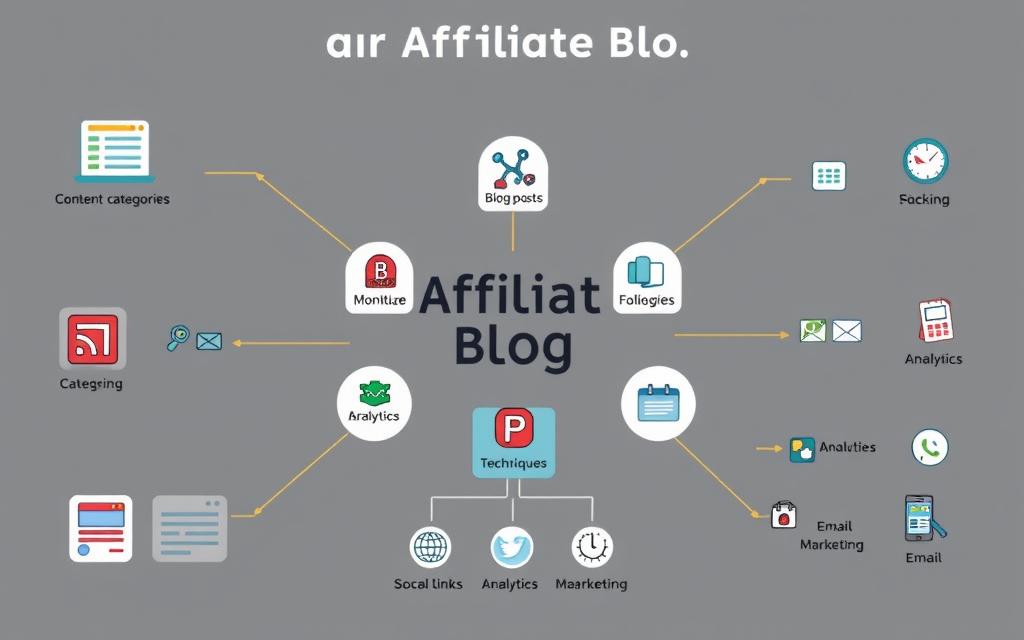In the world of digital marketing, keyword research is key. It’s a crucial part of search engine optimization (SEO). Knowing how to do keyword research can make your website stand out.
But what makes some websites succeed in SEO while others struggle? It’s all about understanding keyword research.
This guide will cover the basics of keyword research. We’ll look at what it is, why it’s important, and how it shapes SEO strategies. By the end, you’ll know how to improve your online presence.
Key Takeaways
- Keyword research is the foundation of effective SEO strategies, enabling you to identify the right keywords to target and optimize your content for.
- Understanding search intent is crucial in keyword research, as it helps you align your content with what users are looking for.
- Leveraging the right keyword research tools can provide valuable insights into search volume, competition, and potential opportunities.
- Incorporating keywords effectively into your content, while avoiding keyword stuffing, is essential for optimal search engine visibility.
- Continuously monitoring and adjusting your keyword strategy is key to staying ahead of the curve in the ever-evolving world of SEO.
What is Keyword Research?
Keyword research is key to a good SEO plan. It finds and studies the search terms for info, products, or services related to your business. Knowing the keyword research, search volume, and competitive analysis helps you make content that meets your audience’s needs. This can bring more visitors and leads to your site.
Definition and Importance
Keyword research is the first step in SEO. It lets you know what your audience is looking for. By finding the right keywords, you can make your site more visible in search results. This makes it easier for people to find your business.
Key Components of Keyword Research
- Identifying relevant terms and phrases related to your business, products, or services
- Analyzing the search volume of these keywords to determine their popularity and potential impact
- Assessing the competitive analysis of the keywords to understand the level of competition and the effort required to rank for them
- Discovering long-tail and related keywords that can complement your core keyword strategy
- Continuously monitoring and refining your keyword list to stay ahead of industry trends and customer preferences
Mastering keyword research lets you build a strong SEO plan. This plan can bring more targeted traffic to your site and help you reach your business goals.
The Benefits of Effective Keyword Research
Doing deep keyword research is key to a good SEO plan. It helps find the right keywords and search terms. This way, businesses can boost their SEO rankings, improve their content strategy, and get more website traffic.
Improved SEO Rankings
When your content matches what people are searching for, you’re more likely to rank higher. Good keyword research lets you know what your customers want. This way, you can make content that meets their needs and interests.
Enhanced Content Strategy
Keyword research gives you insights for a better content plan. It helps you find the most important and effective keywords. This lets you create content that solves your audience’s problems and answers their questions.
Increased Website Traffic
Being higher in search results and making content that people like can really boost your website traffic. By optimizing for the right keywords, you can draw in more people who are likely to become customers. This helps your business grow in the long run.
Effective keyword research brings many benefits that can really help your online success. By putting in the work, you can find new chances, beat your rivals, and reach your business goals.
Tools for Keyword Research
Starting a keyword research journey needs the right tools. We’ll look at top keyword research tools like Google Keyword Planner, SEMrush, Ahrefs, and Ubersuggest.
Google Keyword Planner
Google Keyword Planner is a free tool from Google. It gives insights into search volume, competition, and cost-per-click. This helps businesses find the best keywords for their content and ads.
SEMrush
SEMrush is a top keyword research tools with lots of data and features. It helps find keyword opportunities, track competitors, and analyze search rankings. It’s perfect for all your keyword research needs.
Ahrefs
Ahrefs is a well-liked keyword research tools that gives deep insights. It shows search volume, difficulty, and potential. Its easy-to-use interface and strong data analysis make it valuable for marketers and SEO experts.
Ubersuggest
Ubersuggest is a free keyword research tools with many features. It offers keyword suggestions, search volume data, and keyword difficulty analysis. It’s ideal for exploring new keywords and improving content strategy.
Using these keyword research tools, businesses can find valuable insights. They can identify high-potential keywords and create a content strategy that meets their audience’s needs.
Understanding Search Intent
Keyword research is more than just finding popular terms. It’s about understanding the search intent behind them. This intent shows why users search for something. It falls into four main types: informational, navigational, commercial, and transactional.
Types of Search Intent
- Informational – Users seeking to learn or acquire information on a particular topic.
- Navigational – Users looking to find a specific website or web page.
- Commercial – Users researching products or services with the intent to make a purchase.
- Transactional – Users ready to take a direct action, such as making a purchase or completing a form.
Why Search Intent Matters
Understanding search intent helps align your content with what users need. By knowing why people search, you can make content that matters to them. This can boost your SEO rankings, improve user engagement, and increase website traffic and sales.
Using search intent in your keyword research and content strategy helps meet user needs. This approach can give your business an edge and lead to lasting SEO success.
The Keyword Research Process
Starting with thorough keyword research is key to a good SEO plan. It’s a detailed process that includes finding your niche, making a big list of keywords, and looking at what your competitors do. This method helps you find the best keywords for your content and marketing.
Identifying Your Niche
The first thing to do is figure out your niche. What industry or topic do you focus on? What main products or services do you offer? Knowing your niche helps you narrow down your keyword search and reach the right people.
Generating a Keyword List
After you know your niche, start thinking of keywords. Use tools like Google’s Keyword Planner, Ubersuggest, and SEMrush to find lots of relevant keywords. It’s important to have a wide and varied list of keywords that cover all parts of your niche.
Analyzing Competitors
Looking at what your competitors do with keywords is very important. Find the top sites in your field and see what keywords they use. This can show you new keywords to try and where you can make your content stand out.
By following these steps, you’ll get a strong list of keywords. This list will help your content, SEO, and marketing grow. Keeping your keyword research up to date is crucial to stay ahead in your field.
Long-Tail vs Short-Tail Keywords
In the world of SEO, knowing the difference between long-tail and short-tail keywords is key. These keywords help bring targeted traffic and boost your site’s visibility.
Definitions and Examples
Short-tail keywords are broad and generic, with lots of searches but lots of competition too. Think “best digital camera” or “travel deals.” Long-tail keywords, on the other hand, are more specific and niche, with less search volume but less competition. Examples include “best mirrorless camera for landscape photography” or “cheap flights from New York to Paris in June.”
Pros and Cons of Each Type
- Short-tail keywords: They can bring a lot of traffic, but it’s hard to rank high because of the competition. They’re often used by big, established sites.
- Long-tail keywords: They have lower search volume but are more specific, which means they can lead to more conversions. They’re easier to rank for, especially for smaller sites.
Using both short-tail and long-tail keywords in your SEO strategy can be very effective. Short-tail keywords help increase awareness and visibility. Long-tail keywords attract more qualified traffic. By understanding the keyword difficulty of each, you can create content that targets the best keywords for your business.

“The key to successful SEO is understanding the nuances of short-tail and long-tail keywords and leveraging them strategically to drive traffic and conversions.”
Analyzing Keyword Difficulty
In the world of SEO, keyword research is key to success. Knowing how hard it is to rank for a keyword is vital. This is where keyword difficulty comes in.
What is Keyword Difficulty?
Keyword difficulty is about how hard it is to rank for a keyword on search engine results pages (SERPs). It looks at search volume, how good and authoritative other websites are, and how competitive the industry is.
Knowing the keyword difficulty helps you find the best keywords to target. It lets you focus on keywords you can rank for, avoiding those that are too hard.
Methods to Assess Difficulty
There are many ways to figure out keyword difficulty. You can use tools or do it manually. Here are some common ways:
- Consulting Keyword Research Tools: Tools like Google Keyword Planner, SEMrush, and Ahrefs give keyword difficulty scores. They show how competitive a term is.
- Analyzing Competitor Websites: Look at the search volume, domain authority, and content quality of top websites. This helps understand the competition.
- Considering Search Intent: Knowing why people search for a keyword helps. It tells you how hard it is to rank for that term.
Using these methods helps you choose the right keywords. This way, you can improve your chances of getting better search engine rankings.
Incorporating Keywords into Content
Good SEO is more than just picking the right keywords. The real challenge is to blend those keywords into your content smoothly. By using the best practices for keyword placement, you can make your pages more visible and relevant on search engine results pages (SERPs).
Best Practices for Keyword Placement
Putting your keywords in the right spots is key for better content. Here are some important tips:
- Put your main keyword in the title tag, a top SEO element.
- Include your focus keyword in the first paragraph to set the topic for search engines.
- Use relevant keywords throughout your text, making sure it flows well and doesn’t feel stuffed.
- Optimize your meta description with your target keyword to boost click-through rates from SERPs.
- Use keywords in subheadings (H2, H3 tags) to make your content easier to scan.
Avoiding Keyword Stuffing
It’s important to use keywords but avoid stuffing them. Stuffing too many keywords can hurt user experience and may get you penalized by search engines. Instead, aim for natural, engaging content that naturally includes your target keywords.
By finding the right balance between keyword optimization and engaging content, you can use SEO to bring more organic traffic to your site.
Local Keyword Research Techniques
As a business owner, focusing on local SEO can change the game. It boosts your online presence and reaches local customers. This strategy improves your search rankings and meets your local audience’s needs.
Importance of Local SEO
Local SEO is key in today’s online world. It helps your site show up in local searches. This can bring more visitors, engagement, and sales to your business.
Tools for Local Keyword Research
- Google My Business: Use this free tool to manage your online presence and see what local customers search for.
- Google Trends: Check search trends and keyword popularity in your area. It helps find the best local keywords.
- Bing Places for Business: Like Google My Business, it lets you control your online info and learn about local search trends.
- Ahrefs: This SEO tool has features like Keyword Explorer. It finds location-based keywords and analyzes their search volume.
Using these tools and techniques can boost your local SEO. It makes your site more visible in local searches. And it helps you connect with your audience better.
Keeping Up with Trends
The world of digital marketing is always changing. It’s key to keep up with the latest trends and changes. Google Trends is a powerful tool for keyword research. It helps you understand search volume and industry shifts, giving you insights to improve your content strategy.
Using Google Trends
Google Trends offers a lot of information on search topics and keywords. It shows how search volume changes over time. This helps you find new keywords and understand seasonal trends in your field. It’s very useful for planning your keyword research and content.
Monitoring Industry Changes
It’s also important to watch for big changes in your industry. This includes shifts in consumer behavior, new technologies, and new competitors. By keeping an eye on these, you can adjust your keyword research and content strategy to meet your audience’s changing needs.
Keeping up with trends and adjusting your keyword research is key to long-term SEO success. Using tools like Google Trends helps you stay relevant. This way, your content will continue to engage your audience and rank well in search results.

| Feature | Benefit |
|---|---|
| Trend Analysis | Identify emerging keywords and seasonal fluctuations |
| Competitor Monitoring | Analyze what your competitors are targeting and how their strategies are evolving |
| Industry Insights | Stay informed about broader changes and adapt your content accordingly |
Evaluating Keyword Performance
Mastering keyword research is key for SEO success. But it doesn’t stop there. You must also evaluate your keyword performance. This step helps refine your strategy and drive results.
By tracking important metrics, you can understand how your keywords are doing. This knowledge lets you adjust your content and targeting.
Key Metrics to Track
There are several key metrics to watch when evaluating keyword performance:
- Search Volume: This shows how many times a keyword is searched, giving insight into demand and reach.
- Click-Through Rate (CTR): It’s the percentage of users who click on your content in search results. It shows how relevant and appealing your content is.
- Conversion Rate: This is the percentage of users who take a desired action, like buying something or filling out a form. It shows how well your keyword-driven content works.
Tools for Performance Analysis
Using the right tools is crucial for analyzing keyword performance. Here are some top options:
- Google Analytics: This platform gives detailed data on website traffic, user behavior, and page performance. It helps track the impact of your keyword-driven content.
- SEMrush: A leading SEO tool that offers insights into keyword metrics, competitor analysis, and content performance. It helps optimize your keyword strategy.
- Ahrefs: Another top SEO solution that tracks keyword rankings, organic traffic, and backlink profiles. It provides valuable data to refine your approach.
By regularly monitoring these metrics and using the right tools, you can understand your keyword performance better. This knowledge helps you make data-driven adjustments. It unlocks the full potential of your SEO efforts.
Making Adjustments to Your Strategy
In the world of search engine optimization (SEO), being flexible is key. The digital world changes fast. What worked yesterday might not today.
When to Reassess Your Keywords
It’s important to check and update your keywords often. Here are signs you need to look at your strategy:
- Your website’s organic traffic has plateaued or declined.
- Your competitors are outranking you for key search terms.
- Google’s algorithm updates have resulted in significant changes to your rankings.
- Your target audience’s search behavior or preferences have shifted.
Adapting to Algorithm Changes
Search engines like Google update their algorithms often. These updates help users find better results. When changes happen, you need to adjust your keyword strategy quickly. Here’s how:
- Closely monitor industry news and SEO updates to stay informed about algorithm shifts.
- Analyze your website’s performance and identify any significant changes in rankings or traffic.
- Revisit your keyword research and consider adjusting your focus to align with the new algorithm priorities.
- Optimize your content to ensure it provides a seamless user experience and delivers value to your target audience.
By keeping up with digital changes and adjusting your keyword strategy on time, you can stay ahead. This helps your website keep its good ranking in search results.
“Successful SEO is not about tricking search engines—it’s about partnering with them to provide the best search experience.”
Conclusion: Mastering Keyword Research for Success
Keyword research is key in the world of SEO. It helps businesses make their websites more visible. This leads to more targeted traffic and helps reach goals.
We’ve covered the basics of keyword research in this article. We talked about its importance and how to use tools like Google Keyword Planner and SEMrush. Understanding search intent and keyword difficulty is also crucial.
Learning how to do keyword research well lets you create content that people want to read. It helps improve your website and your ranking on search engines. Follow the strategies in this guide to see your SEO success grow.












Leave a Reply